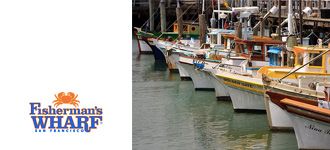
Making Fisherman’s Wharf more walkable, bikeable

Making Fisherman’s Wharf more walkable, bikeable
Fisherman’s Wharf merchants are betting that a remake of the district’s main artery to encourage more walkers and bikers will make it an even bigger draw.
San Francisco Business Times – by Eric Young. June 22, 2012
Fisherman’s Wharf merchants are betting that a remake of the district’s main artery to encourage more walkers and bikers will make it an even bigger draw.
A stretch of Jefferson Street between Hyde and Powell streets will undergo a $4 million renovation that will widen sidewalks, add landscaping, redesign intersections and allow for more outdoor seating for eateries.
The project is expected to start in October and finish by July 2013, giving the neighborhood a new feel in time for America’s Cup racing.
The general Fisherman’s Wharf milieu remains the same: a dense mix of seafood restaurants, curio shops, hotels and fish processing facilities.
But the sidewalk changes are designed to make the area more inviting to tourists and locals because it will give them more room to walk and bike. Meanwhile, the narrower streets are meant to send the message to drivers that they should slow down along Jefferson or choose another street altogether.
Overcrowding:
While the design for Fisherman’s Wharf was being discussed, a survey of tourists and natives showed that the top complaint about the area — which attracts about 25,000 people per day — was overcrowding, said Rodney Fong, president of the Fisherman’s Wharf Wax Museum and real estate investor. “It confirmed to us we needed to make pedestrians and bikes a priority.”
The remade Fisherman’s Wharf will recall — but not try to copy — other noted areas where strolling and biking are the main way to get around a shopping/eating district, like Santa Monica’s Third Street Promenade or Miami Beach’s Lincoln Road.
“It’s not being done to make it like Disneyland,” said Troy Campbell, executive director of the Fisherman’s Wharf Community Benefit District. It was important to shopkeepers and other longtime residents of the area that Fisherman’s Wharf maintain its character, Campbell said.
“On a busy day, it should feel like an outdoor plaza, an urban living space,” said Neil Hrushowy, project manager in the city’s Planning Department.
The remake will be paid for with money from the Department of Public Works, he said.
Some local merchants said they looked forward to seeing the final product. The urban design firm hired by the city, Gehl Architects from Copenhagen, drew inspiration from big cities around the world.
“What happens (in San Francisco) is we tend to think about what we know and we don’t really think about what has been successful in other cities,” said Tom Creedon, president of Scoma’s restaurant, which has been on Fisherman’s Wharf since the 1960s. “The trend is getting people out of their cars and walking in the streets.”
The changes will come only after some disruption to businesses, city officials said. Construction is scheduled to start after the conclusion of Fleet Week this October.
“Everyone knows that short term pain is long term gain,” said Campbell.
The community benefit district, he said, will keep merchants updated about when construction is slated to start near their business.
Years of discussion:
It took Fisherman’s Wharf many years to get to the point where there was enough support to move ahead with a revamped Jefferson Street.
“It’s been a long time coming,” said Creedon. Several years ago when talks about a reworked street began, “discussions were very heated. It seemed like it might not go anywhere.”
Some factions didn’t want any change. Others could not agree on what design elements should be used.
“There wasn’t consensus from merchant owners and tenants and stakeholders,” said Fong. But a break came a few years ago when Fisherman’s Wharf started the community benefit district, in which property owners pay a special tax to pay for additional services.
The CBD served as a central forum to trade ideas on Jefferson Street, he said. Finally people were able to reach common ground.
Another push came in 2010 after San Francisco won the right to host the 2013 America’s Cup.
“I think the America’s Cup really expedited the process a little more,” said Campbell. When “you’ve got company coming you want your living room cleaned.”
For more information visit www.visitfishermanswharf.com